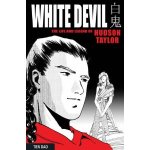To the Protestant Christian communities of East Asia, Hudson Taylor is a founding hero. He lives in their collective memory as the brave, anti-racist man who brought salvation to their ancestors. I am his descendant. Hudson was born on 21st May 1832 in Old Mill Lane, Barnsley – 17 miles from where I live now. He trained in medicine and then decided to be a medical missionary in China.
In 1853 at the age of 21 he left England and spent five months sailing before he reached Shanghai. He found out the hard way that in Chinese folklore the devils wore black and had long hair. So it is obvious what the local people called the long-haired missionaries with black coats! Many of the first Christian missionaries were stoned and driven away.
Hudson did something no Christian missionary had ever done before. He tied his hair in a Chinese queue, shaved his forehead and wore a light coloured quilted cotton coat. An exceptionally talented linguist, Hudson found the best preaching was direct to the people without an interpreter. These improvements resulted in success. The people stayed to listen to his preaching and a community of believers grew steadily.
I am familiar with the superb two volume hardback biography of Hudson written by his son Howard Taylor and his wife and published in 1911 and 1918. What would I make of a 21st century paperback manga, written and drawn in Hong Kong for young people who read Mandarin and then translated into English?
Well, its amazingly good! Unlike the 1911 and 1918 books it is heroic and romantic, sad and triumphant and keeps to a strong story line throughout. And it’s accurate. You get a real sense of what was happening at each stage in Hudson’s life, his failures and triumphs and yet it follows the narrative facts detailed in the big biography very closely. The author, Tien Dao, clearly respects Hudson and his life’s work – the China Inland Mission.
I’ve some minor criticisms. The title of the manga White Devil: the life and legend of Hudson Taylor is inaccurate. Hudson was first referred to, when he looked like a European missionary, as a ‘black devil’. There is a positive inaccuracy – this manga is not really about a ‘legend’. Tien Dao has kept it faithful to history, entertainingly accurate.
A few anachronisms in the drawing will make you smile. Click the diagram above to look at the left hand page. The young man is drawn wearing a modern backpack instead of a nineteen century leather shoulder satchel! In Spring 2010 the ‘cross-shoulder bag’ has now come back as the latest women’s fashion!
Overall, White Devil is perfect for its readership. An accurate and moving tribute to a brave, energetic and brilliant man. Appropriately, it’s published by Lion Hudson!






 Posted by the author
Posted by the author 




